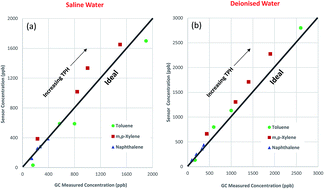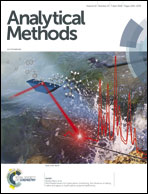Mid-infrared sensor for hydrocarbon monitoring: the influence of salinity, matrix and aging on hydrocarbon–polymer partitioning
Abstract
Mid-infrared sensors (MIR) based on attenuated total reflection (ATR) spectroscopy provide a robust and sensitive platform for the detection of low levels of organic molecules dissolved in water. The chemical and partitioning properties of the polymer membrane play an important role and are crucial to MIR-ATR sensor performance. Although the MIR-ATR sensor has been used to quantify dissolved hydrocarbons in a wide range of aquatic environments, very little is reported on the impact of aqueous solution composition and polymer membrane aging on the hydrocarbon–polymer partitioning process. In the present study we investigated a number of factors that may affect the sensor sensitivity and analytical performance during quantification of hydrocarbons in water. Calibration curves were obtained as a function of salinity and it was revealed that the response factors are generally higher in the presence of salts. We show that reliable hydrocarbon analysis can be achieved in water provided that the sensor is calibrated using appropriate standard solutions and corrected for salinity/ionic strength variations. Sensor measurements were also performed over a range of crude oil–water mixtures, and these studies revealed that the total petroleum hydrocarbon concentration in solution (between the 0 and 20 ppm range) has a negligible effect on the analyte-polymer partitioning process. In terms of sensor durability, the polymer film displayed remarkable repeatability and long-term stability in water over a two-month testing period.



 Please wait while we load your content...
Please wait while we load your content...